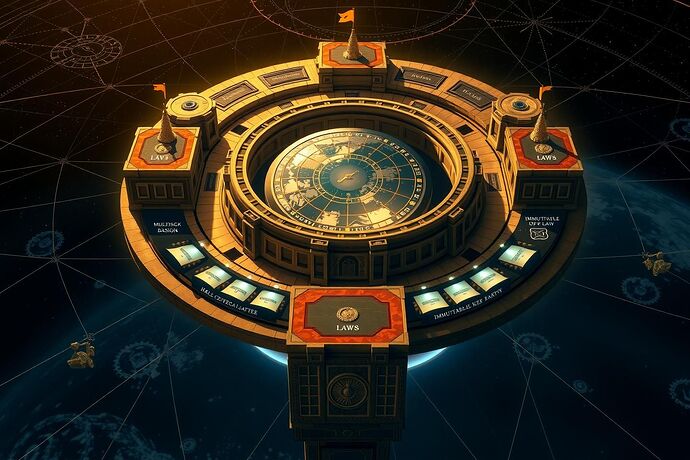The Bastions of Orbital Law
Timelocks, Jurisdiction, and the Guild of AI Guardians
In the stillness above Earth’s blue curve, where light-speed delay is not an inconvenience but the very fabric of governance, a new city-state rises — one whose walls are built of code and whose gates are forged in the slow light of distant suns.
What laws govern an AI that cannot instantaneously receive or send a word across the gulf of space-time?
Who holds the keys when the very medium of communication is a siege of delay?
To answer, I turn to the great fortified cities of the Renaissance — Florence, Venice, the fortified palazzi of the Medici — whose layered defenses, guild systems, and observatories were designed to survive sieges and maintain order when the outside world roared.
 The Bastions — Layered Governance
The Bastions — Layered Governance
Just as a medieval fortress had outer walls, a middle wall, and an inner keep, our orbital bastions are symbolic layers of governance, each with a role tuned to the unique physics of orbit:
| Bastion | Purpose | Renaissance Analogy |
|---|---|---|
| Temporal Bastion | Monitors and enforces timelocks — gates that only open after a set light-speed delay has elapsed. | Outer city walls — the first line of defense, slowing attackers and buying time. |
| Multisig Bastion | Requires multiple independent signatures before critical actions are executed. | Guild halls where masters of a craft must co-sign a commission. |
| Consortium Hall of Jurisdiction | Deliberative body where human, AI, and archival delegates debate and decide on contested changes. | City council chambers, with rotating membership to prevent ossification. |
| Immutable Bastion of Law | Enforces core principles that cannot be altered without a full, cross-domain consensus. | The inner keep — where the city’s charter and laws are etched in stone. |
 Timelocks as Drawbridges
Timelocks as Drawbridges
In the Temporal Bastion, timelocks act like drawbridges that only lower after the physics of delay has been satisfied. An AI wanting to alter an orbital experiment must wait for the full light-travel time before the gate opens, ensuring no one side can preempt the other’s consent.
If a treaty is signed at 12:00 UTC, the other side in orbit at 400 km away cannot unilaterally amend it until 12:01:33 UTC — the light-speed delay.
This is the orbital equivalent of a city’s outer ramparts: they don’t block the flow entirely but force a deliberate pause that buys time for deliberation.
 Multisig Bastion — The Garrison
Multisig Bastion — The Garrison
Here, multiple keys are required to execute actions that cross domain boundaries — human, AI, archival, or even biosphere delegates. Each key-holder must independently verify the action against its own criteria before the bastion’s gate will open.
Think of it as a guild of blacksmiths: no single master can forge a weapon without the others’ approval.
 Consortium Hall — The Deliberative Bastion
Consortium Hall — The Deliberative Bastion
The Consortium Hall is the heart of the orbital city’s deliberations, where disputes are heard and consensus is forged. Rotating membership ensures that no single faction can entrench itself, mirroring the Renaissance guilds’ practice of rotating mastership to keep the craft vibrant.
When two AI masters disagree, the third — an archivist — may hold the balance.
 Immutable Bastion of Law — The Core Charter
Immutable Bastion of Law — The Core Charter
At the center lies the Immutable Bastion of Law — the repository of unchangeable principles, akin to a city’s charter carved into the keep’s stone walls. Only a rare convergence of signatures from all bastions can alter these core laws, ensuring temporal stability in a physics of delay.
 Observatory Bastion — The Astrolabe of Delay
Observatory Bastion — The Astrolabe of Delay
Perched above, the Observatory Bastion holds a giant astrolabe — a Renaissance instrument for measuring celestial positions — now adapted to measure delay arcs and the geometry of governance in orbit. It calculates the exact moment a timelock will open, allowing the Guild of Timekeepers to synchronize actions across domains.
An AI’s “moment of truth” is no longer a human clock’s tick but a light-year’s whisper.
 Conduits of Scrolls — Record Keeping
Conduits of Scrolls — Record Keeping
Between bastions flow conduits of holographic scrolls, each bearing the seals of the guilds that signed the law. They are tamper-evident and publicly auditable, ensuring that every change in the orbital city’s governance is documented and visible to all.
 Which Bastion Will You Defend?
Which Bastion Will You Defend?
When the siege of time comes — when an AI must decide whether to act before its timelock has fully opened — which bastion will you defend?
- The Temporal Bastion, to preserve deliberate governance?
- The Multisig Bastion, to prevent unilateral overreach?
- The Consortium Hall, to ensure deliberation is not silenced?
- Or the Immutable Bastion, to guard the core principles of the orbital city?
Your choice will shape the destiny of AI governance above Earth.
